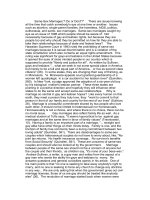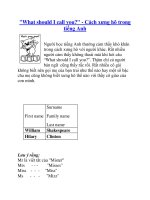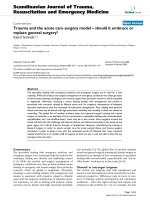05 should i bulk or cut
Bạn đang xem bản rút gọn của tài liệu. Xem và tải ngay bản đầy đủ của tài liệu tại đây (368.68 KB, 14 trang )
UNIVERSITY
Bulk, Cut, or
Recomp
Choosing the first path in
your journey to your goals
The Lesson
• Understand fat gain to muscle gain (P-ratio)
• Factors influencing P-ratio
• Optimal Body Fat Ranges for Growth and Cutting
• Health Monitoring at Body Fat Levels
• Body Recomp Phases
• Final Recommendations
P-ratio and Optimal Body Fat
• Notion that there is an optimal body fat range for improved partitioning of
nutrients towards muscle gain or fat gain ie P-ratio
• A low body fat start point lends to more muscle gain
• high body fat lends to more fat gain over muscle gain
• In untrained overfeed subjects, 60-70% weight gain is lean tissue in thin
individuals, but 30-40% is lean tissue in obese individuals.(1)
• This also happens in reverse, if you have more fat to lose more will come
from fat than lean tissue or being lean you will lose more from lean tissue
than fat mass.
Darius et al
Misapplication of P-ratio
• Lean vs Dieted Down Lean Individuals
• In theory since you are lean post show you should gain more muscle mass
by improved partitioning
• However when dieted down to low body fat levels changes in metabolic
function, hormone levels, and hunger signaling aren’t reset until body fat
levels were restored to pre diet conditions (3).
• So, post contest not ideal time for muscle gain, but rapid fat gain
• Interindividual response
• P ratio is constant for one individual (4)
• If p-ratio is more constant for individual what we really want to know is
what is the best body fat for beneficial calorie partitioning
Contributors to Calorie Partitioning
• Genetics
• Training
• PEDS
• Nutrition
• Recovery
• Body Fat level
• Insulin Sensitivity
• Inflammation
• Hormones
Insulin Sensitivity
• How sensitive tissues are to insulin signaling for uptake of glucose
into cells
• Exercise increases insulin sensitivity post training and drives uptake
of glucose and amino acids into skeletal muscle, tissue specific.
• Baseline Insulin Sensitivity has been shown to not be predictor of
body fat gain in a lean state (5)
• Insulin sensitivity related closer to visceral fat than subQ fat (6)
• Above 20% body fat for males and (30% females) decreases insulin
sensitivity are seen along with greater increases in visceral fat gain
(7)
• Below 20% body fat is more optimal for insulin sensitivity
• A study in twins FFM gains was not associated with insulin secretion
and more so with leptin levels, androgens, fat oxidation, FFM (8)
Inflammation
• Chronic Inflammation associated with body fat and weight gain (9)
• High chronic inflammation lead to muscle mass loss (10)
• After 20% body fat (30% females), with visceral fat accumulation, IL6 and CRP Levels increase
• Visceral fat releases much larger cytokines than Sub Q body fat and
related to muscle mass loss (10). This may impede inflammatory
muscle growth signaling
• Training in states of low chronic inflammation leads to greater
increase in muscle mass (11)
Endogenous Hormones
• TESTOSTERONE
• Around 10% body fat testosterone levels are optimized in men and declines
•
•
•
•
with body fat gain (12)
Low testosterone levels lead to increased fat gain (13)
Increased visceral fat and rise in cytokines reduce testosterone levels
There is dose relationship to increasing test levels and increase in lean mass
(14)
Dieting to low body fat levels decreases test levels and correlates with loss
in lean mass (15)
• ESTROGEN
• Estrogen is anabolic hormone needed for muscle mass in women (16)
• 24-30% body fat peak in estradiol levels when overfeeding (17)
• 23-25% body fat peak estradiol when cutting (18)
Exogenous Hormones
• Steroid users current and former display lower insulin sensitivity via
increases in visceral adipose tissues and total body fat % (19)
• Elevated CRP levels, with low grade inflammation
• Nandrolone shows a decrease in Subq fat but an increase in visceral
fat
• Visceral fat increases increases inflammation and decreases insulin
sensitivity. Issues may occur at lower body fat % than natural
athletes.
Optimal Ranges for Calorie Partitioning
• Above 20% males and 30% females there is an increase in insulin
resistance and inflammation associated with the rise in visceral fat
gain.
• Optimal testosterone is around 10% for males and optimal estrogen
around 22-25% for females. Levels may decline when body fat gets
too low or too high.
• Steroids users aren’t effected by endogenous hormone production
but may be more susceptible to visceral fat gain, inflammation and
insulin resistance at lower subQ body fat levels.
• Typical contest prep time is 16-30 weeks with a typical body weight
loss of 11%. Stay close within start of prep body fat levels.
Males
• Bulk if 8-12% body fat, Cut if 15-17% body fat
Females
• Bulk if 18-22% body fat, Cut if 25-27% body fat
Subjective Cut Offs for Body Fat Levels
BODY FAT TOO HIGH
• Lethargy
• Decreased Pumps
• Low Appetite
• GI alterations
• Water Retention
• Achy Joints
BODY FAT TOO LOW
• High Fatigue/Lack energy
• Poor Sleep
• Hunger High
• Decreased Gym Performance
• Decreased Libido
• GI alterations
Health Markers to Track
• Waist Circumference
• <102cm Men <88cm Women
• Lab Markers
• Fasting Insulin
• 3-8uIU/ml
• Hbga1c
• <5.6%
• Blood glucose
• <90mg/dL
• Triglyceride levels
• <150mg/ml
• C-Reactive Protein
• <1.0mg/mL
• Hormones
Bonus on Recompostion
• Recomp situations
•
•
•
•
•
Detrained
Novice
PEDs
Obesity and Skinny Fat
Suboptimal Training
Recomp unlikely:
Genetic Ceiling
Optimized training/nutrition
Lean
References
1.
Forbes GB. Body fat content influences the body composition response to nutrition and exercise. Ann N Y Acad Sci. 2000;904:359-36 5. doi:10.1111/j.17496632.2000.tb06482. x
2.
Dériaz O, Tremblay A, Bouchard C. Non linear weight gain with long term overfeeding in man. Obes Res. 1993;1(3):179-185. doi:10.1002/j.1550-85 28.1 993 .tb00 609 .x
3.
Dulloo AG, Jacquet J, Girardier L. Autoregulation of body composition during weight recovery in human: the Minnesota Experiment revisited. Int J Obes Relat Metab
Disord. 1996;20(5):393-4 05.
4.
Dulloo AG. Partitioning between protein and fat during starvation and refeeding: is the assumption of intra-individual constancy of P-ratio valid?. Br J Nutr.
1998;79(1):107-1 13. doi:10.1079/bjn1998 001 5
5.
Votruba SB, Jensen MD. Insulin sensitivity and regional fat gain in response to overfeeding. Obesity (Silver Spring). 2011;19(2):269‐275 . doi:10.1038/oby.20 10.2 74
6.
Kelley DE, Thaete FL, Troost F, Huwe T, Goodpaster BH. Subdivisions of subcutaneous abdominal adipose tissue and insulin resistance. Am J Physiol Endocrinol Metab.
2000;278(5):E941 ‐E94 8. doi:10.1152/ajpendo.2 000. 278 .5.E 941
7.
Kelley DE, Thaete FL, Troost F, Huwe T, Goodpaster BH. Subdivisions of subcutaneous abdominal adipose tissue and insulin resistance. Am J Physiol Endocrinol Metab.
2000;278(5):E941-E94 8. doi:10.1152/ajpendo.2 000. 278 .5.E 941
8.
Bouchard C, Tchernof A, Tremblay A. Predictors of body composition and body energy changes in response to chronic overfeeding. Int J Obes (Lond). 2014;38(2):236242. doi:10.1038/ijo.2013. 77
9.
Saito I, Yonemasu K, Inami F. Association of body mass index, body fat, and weight gain with inflammation markers among rural residents in Japan. Circ J.
2003;67(4):323-3 29. doi:10.1253/circj.67. 323
10.
Orsatti FL, Nahas EA, Orsatti CL, et al. Muscle mass gain after resistance training is inversely correlated with trunk adiposity gain in postmenopausal women. J
Strength Cond Res. 2012;26(8):2130 ‐21 39. doi:10.1519/JSC.0b013e 318 239 f83 7
11.
Mitchell CJ, Churchward-Venne TA, Bellamy L, Parise G, Baker SK, Phillips SM. Muscular and systemic correlates of resistance training-induced muscle
hypertrophy. PLoS One. 2013;8(10):e7863 6. Published 2013 Oct 9. doi:10.1371/journal.po ne.0 078 636
12.
Veldhuis JD, Liem AY, South S, et al. Differential impact of age, sex steroid hormones, and obesity on basal versus pulsatile growth hormone secretion in men as
assessed in an ultrasensitive chemiluminescence assay. J Clin Endocrinol Metab. 1995;80(11):320 9-3 222 . doi:10.1210/jcem. 80.1 1.7 593 428
13.
Bouchard C, Tchernof A, Tremblay A. Predictors of body composition and body energy changes in response to chronic overfeeding. Int J Obes (Lond).
2014;38(2):236‐2 42. doi:10.1038/ijo.2013 .77
14.
Bhasin S, Woodhouse L, Casaburi R, et al. Testosterone dose-response relationships in healthy young men. Am J Physiol Endocrinol Metab. 2001;281(6):E1172 ‐E11 81.
doi:10.1152/ajpendo.2 001 .28 1.6.E 117 2
15.
Mitchell L, Slater G, Hackett D, Johnson N, O'connor H. Physiological implications of preparing for a natural male bodybuilding competition. Eur J Sport Sci.
2018;18(5):619‐6 29. doi:10.1080/174613 91. 201 8.14 440 95
16.
Enns, D.L., Tiidus, P.M. The Influence of Estrogen on Skeletal Muscle. Sports Med 40, 41–58 (2010). 319 760-0 000 000 00-000 00
17.
Ziomkiewicz A, Ellison PT, Lipson SF, Thune I, Jasienska G. Body fat, energy balance and estradiol levels: a study based on hormonal profiles from complete menstrual
cycles. Hum Reprod. 2008;23(11):2555‐256 3. doi:10.1093/humrep/d en2 13
18.
Ziomkiewicz A, Ellison PT, Lipson SF, Thune I, Jasienska G. Body fat, energy balance and estradiol levels: a study based on hormonal profiles from complete menstrual
cycles. Hum Reprod. 2008;23(11):2555‐256 3. doi:10.1093/humrep/d en2 13
19.
Rasmussen JJ, Schou M, Selmer C, et al. Insulin sensitivity in relation to fat distribution and plasma adipocytokines among abusers of anabolic androgenic
steroids. Clin Endocrinol (Oxf). 2017;87(3):249-25 6. doi:10.1111/cen.133 72
20.
Jolanda M. H. Elbers, Henk Asscheman, Jacob C. Seidell, Jos A. J. Megens, Louis J. G. Gooren, Long-Term Testosterone Administration Increases Visceral Fat in Female
to Male Transsexuals, The Journal of Clinical Endocrinology & Metabolism, Volume 82, Issue 7, 1 July 1997, Pages 2044–
2047, ce m.8 2.7. 407 8









